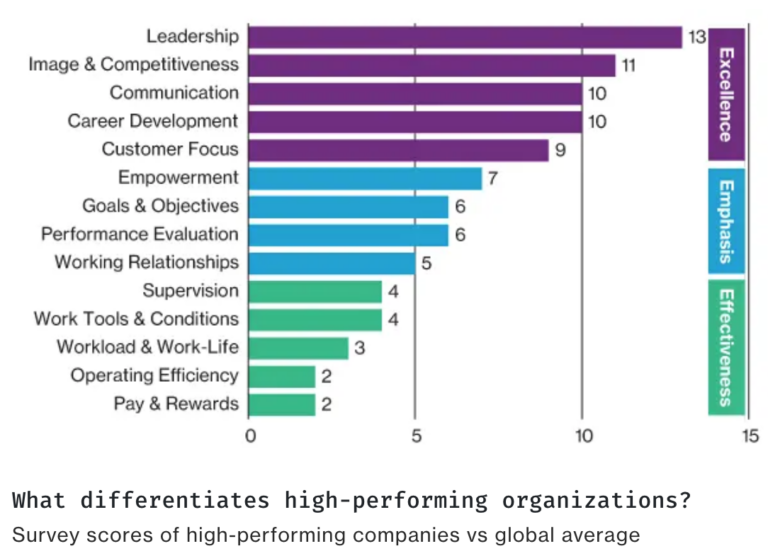Employee experience can make or break a company.
If that sounds like an overstatement, consider this: 33% of employers are currently considering employee experience mandates at the c-suite level.
Employees are a company’s biggest asset. But with the workplace changing in unprecedented ways, business leaders are realizing that employee engagement initiatives and company culture initiatives don’t cut it anymore.
Focusing on a few, narrow aspects of work life is no longer enough to recruit, retain, and nurture top talent. If companies want to succeed in the new world of work, they must take a more holistic approach and focus on the entire employee experience.
Unfortunately, only 9% of companies say they’re ready to address employee experience in any meaningful way.
Companies know EX is important. And they want to deliver the best employee experience possible. But designing a positive employee experience from end to end is challenging, especially for remote organizations that have unique communication challenges and less direct control over employee work environments.
To help you navigate EX remotely or in person, we’ve created this comprehensive employee experience guide. Learn why EX is so important, how top companies address it, and how to invest in and improve the employee experience within your own organization.
What is employee experience?
The name “employee experience” sums it up pretty neatly. It’s as intuitive as it sounds.
Employee experience is everything your employees encounter, deal with, and see as they do their work. This includes all the physical, technological, and interpersonal aspects of the job.
In other words, employee experience starts with the recruiting process, ends with the exit interview, and encompasses everything in between. Traditional tactics like employee engagement go a long way toward creating happier, more fulfilled employees. But employee experience is much broader and more all-encompassing than any single initiative.
Intentionally designing your company’s EX requires going beyond popular work policies and programs. It involves a commitment to improving everything from the way your company communicates, to the relationships you build between teams, to the software and tools you choose to work with.
Improving the employee experience isn’t for the faint of heart. But it’s benefits are worth all the extra effort.
Create videos that drive action
Activate your audience with impactful, on-brand videos. Create them simply and collaboratively with Biteable.
Why employee experience is so important
The employee experience is going to happen whether you manage it or not. Everything in an employee’s working environment — from their mouse, to their supervisor’s management style, to the collaboration tools your company uses — contributes to their employee experience.
Because employee experience is so dependent on the day-to-day, minute-to-minute experience of working for the company, some of it is going to be outside of your control.
But there are plenty of things about EX that are within your control. It’s important to take these things to heart, because if you don’t manage the employee experience with intention, EX tends to default to being negative. And no one wants that — least of all you and your leadership team.
A negative employee experience has a ripple effect that touches on just about every aspect of business:
25% of all new employees leave the organization within a year. Much of this can be attributed to a poor employee experience.
This includes a subpar onboarding experience (which, according to some experts, is the case at 88% of organizations).
60% of employees say employee well-being improves employee retention.
61% of employees say employee well-being enhances productivity and bottom-line results.
EX directly impacts employee engagement, and companies with engaged workforces earn 147% more per share than those without engaged workforces.
- Lack of employee engagement costs businesses between $450 billion and $550 billion each year.
On the flip side, a positive employee experience has profound effects on business success. Research by Willis Towers Watson reveals that the highest performing companies invest in creating a great employee experience. And they get a better ROI from this than they do from offering competitive salaries.
The study found that the 30 highest-performing companies in the world excel in five areas:
Inspiration
Drive
Trust
Growth
- Market focus
These factors were rated as having four to six times more impact than fair pay.

Companies simply can’t afford to neglect EX. A poorly designed employee experience causes problems at every stage of the game.
Recruiting
Your people have more employment options than ever. This is especially true for employees who can work remotely, because they’re not limited to jobs near where they live.
That means companies — especially remote organizations — must fiercely compete for talent. Not every company can afford to compete on salary alone. And there’s evidence that employees are willing to take a lower salary for a better employee experience.
Investing in delivering the best employee experience is an incredibly cost-efficient way to attract talent and stand out in the crowd. In a competitive landscape, your reputation as a company that values EX matters. It’s not only positive for employees, it’s positive for your employer brand.
Employee performance
If your employees dislike the tools your company provides, or if they don’t have the right tools they need to do their jobs and connect with their team, they’re going to get less done.
People are less productive if they’re unhappy in their workspace. They’re also less productive and less engaged when they feel disconnected from their team and work.
There’s no way to avoid these realities.
Bill Bala, Senior Vice President of Finance at Verb Inc., says that employee connection is so important, company leadership needs to place a far bigger focus on building connections, especially in remote companies:

“While execution and process are still important in remote work, leadership style should shift to a focus of making people feel connected to one another and the organization’s purpose.”
- Bill Bala, Senior VP of Finance at Verb Inc.
Unfortunately, many companies never take the time to ask employees how they feel about their work tools and environment. And it’s even less common for companies to address the personal and social aspects of work, even though all of these things impact employee performance and company productivity.
Retention
This one is straightforward: a bad employee experience makes people dislike their jobs. If your people don’t like where they work, they’ll go work somewhere else. A poor employee experience is bad for employee retention, and high employee turnover is bad for business.
How bad for business?
Studies show that replacing an hourly employee costs about $1500. Replacing employees in technical and executive positions costs as much as 213% of the employee’s salary.
1 in 4 people quit their jobs in 2021. If you do the math on what it would cost to replace 25% of your company’s workforce, the importance and value of employee retention becomes painfully clear.
The bottom line
Hiring and training new employees is incredibly expensive. And, if all your employees are just 1% less productive, that’s a huge bite out of the bottom line. An organization that delivers a poor employee experience is simply less profitable and successful.
Employee experience matters. Companies with a positive EX are 2.2 times more likely to exceed their financial targets. Negative EX causes inefficiencies, damages employer brand, increases turnover, and negatively affects operating costs.
But what should leadership and HR teams focus on when they work to improve the employee experience? Let’s break EX into more manageable chunks.
5 key elements of EX (and how to make the most of each)
The core elements of employee experience can be loosely sorted into two categories: professional and personal.
Both are equally important.
But it’s worth noting that the professional aspects tend to be the most important to an employee at the beginning of their tenure. People typically shift their focus toward the personal aspects of work the longer they work for a company.
These are the critical aspects of building a great employee experience. There are also a few strategies and tactics for addressing each element of EX, on both the personal and professional levels.
1. Recruiting
An employee’s experience with your company starts at first contact — hearing from a recruiter, submitting an application, or contacting the company to inquire about opportunities.
First impressions matter. A bad recruiting experience can sour a new team member’s first day at work and cause issues down the road. And candidates who don’t get the job will tell other potential candidates about their experience, good or bad.
Creating a positive recruiting experience is important for starting a productive employee relationship. It’s also important for your reputation as an employer.
Delivering a good recruiting experience is relatively straightforward:
Create complete and accurate job descriptions. It’s always a bad experience to start a job only to find out it involves responsibilities that weren’t mentioned in the job description.
Use video in your job postings. Video job descriptions are the quickest, most memorable way to communicate job requirements and responsibilities. Video makes your job postings more personal and video job descriptions get more engagement than text posts on LinkedIn.
- Give feedback to candidates who don’t get the job. One of the most frustrating experiences in job hunting is being turned down for a job without any reason why. This makes people complain about your company to other applicants.
Also, if you give feedback that helps a candidate get a different job, they might come back to your company later, with experience and training that one of your competitors paid for.
EX matters every step of that way, from recruiting to offboarding and everything in between. Biteable CEO Brent Chudoba talks about why you can’t afford a poor offboarding experience:
2. Onboarding
Most companies put zero intentional design into their onboarding process.
In fact, onboarding and training are usually additional responsibilities that get thrust upon managers and senior team members. And these team members are still expected to perform their usual duties, despite doing double duty as a trainer.
As anyone who’s been on either side of this equation knows, this approach is far from ideal. An inadequate onboarding process leaves employees feeling under-informed and unprepared to do their job.
This leads to frustration and resentment, especially if employees feel they are expected to do something they were never trained to do. And it indicates to new employees that the company is not willing to invest in its team members.
What’s more, an inadequate onboarding process isn’t good for your company either. You might save a little bit of time and money in onboarding, but you’ll pay for it later in lost productivity and employee turnover.
Fortunately, you can turn your onboarding process into an asset:
Create a comprehensive onboarding and training process. Go beyond policy materials and standard paperwork. Also include training on how to use the necessary tools and software and the specifics of how your company uses those tools.
Allocate time and money specifically to onboarding new employees. Avoid saddling managers and seasoned employees with the task of onboarding new hires. Find a way to take some responsibilities off the trainer’s plate while they get new team members up to speed. That way new hires get the attention and training they deserve.
- Create a package of training videos. Company policy guides and handbooks are good. But let’s face it, people rarely read them and even more rarely retain the information.
A handful of videos covering certain topics is a great trick for highlighting the most important information. Video can be watched on demand, and it makes information easier to consume and remember. (We’ll cover which videos to make in more detail shortly.)
3. Working experience
This is a big one. And it’s one that frequently gets overlooked.
The working experience is an employee’s day-to-day experience of doing the job. Everything from the commute to the workspace lighting is in play here, which is why this part is so easy to forget. Much of it is simply taken for granted.
However, the solution to this isn’t as complicated as it might seem.
Traditional employee engagement techniques work quite well for identifying and solving problems related to the working experience. It’s just a matter of making sure you ask the right questions and routinely solicit feedback on the day-to-day employee experience.
Technological
This involves all the tech tools (hardware and software) your people use on a daily basis. If employees are constantly thwarted and frustrated by your company’s infrastructure, they’re going to be less productive and less satisfied with their jobs.
Most companies are decent at getting employee feedback on big ticket items like industry-specific software suites and workstation computers. But the more common tools are treated as foregone conclusions.
For example, many companies just pick up Slack as their messaging platform without thinking about it too much. In most cases, it’s a great fit. But it’s not a great fit for all companies. And your employees are going to get irritated fast if communication is a constant struggle.
The key is to get feedback on all your tools, even the ones that seem like they should be a slam dunk. This helps you understand what’s causing frustration and friction for employees as they work on their everyday tasks. Then you can work with your teams to correct those issues.
Physical
Physical workspaces are also treated as a foregone conclusion. Here’s your cubicle, or your workstation, or your back-of-the-house layout. Here’s the hardware you need to make it run smoothly. Good luck.
Admittedly, changing your company’s physical workspace can be challenging. But you can make small tweaks that create a more pleasant environment for your employees.
In cases where gear is purchased for new hires, let employees choose their own equipment, or give a stipend for team members to purchase certain work equipment.
For office workers, offer the option of working outside the office when it’s possible. For employees who are tied to a physical location: are there small changes to the layout, or the equipment, or even the breakroom amenities that will make their work easier or at the very least a little more pleasant.
For remote organizations, providing a positive and productive workspace can be especially challenging because you have has much less direct control over your team’s physical environment.
But if your company is remote, you can still help your people build better workspaces by redirecting some of the funding that would usually pay for office space toward helping employees create a home workspace. That way, remote employees aren’t forced to just make do with what they have.
Cultural
The cultural experience is one of the most difficult things to manage, because it’s the least tangible. Switching to new collaboration tools or buying a few pieces of hardware is easy compared to managing workplace interactions.
But it’s important to establish company values and culture and work hard to infuse that culture into every aspect of work.
It’s easy to let business pressures push your company culture off the rails. To mitigate this, create a system for regular check-ins that allows HR and company leadership to spot shifts in company culture and make corrections before the problems become too deeply embedded.
No company sets out to create a company culture that makes people unhappy. But a company culture can devolve into a negative experience if the intended culture is not actively maintained.
4. Community and social experience
In the transition to remote work, the community and social aspect of the office has taken the biggest hit
In a traditional office environment, people naturally interact and socialize. They get together outside of work to socialize. And they have a sense of belonging to a team simply because they see that team on a regular basis.
None of that happens naturally in remote organizations, because everyone is working on their own little island. There’s very little, if any, incidental interaction.
Most remote employees only communicate with their direct supervisor and teammates. There are no natural opportunities for a person to see the rest of the organization and get a sense of how their work fits into the company as a whole.
Remote organizations must invest resources into creating opportunities for employees to socialize and connect. Team building activities are an excellent way to keep remote teams connected and build a sense of community.
Hosting periodic all-hands meetings is another valuable tactic that helps your people see themselves and their work within the bigger picture of the organization.
The key here is to keep these meetings brief and occasional. And make sure that everyone has an opportunity to contribute; nobody likes going to meetings where they aren’t needed.
The ultimate goal is to remind remote employees that they aren’t alone on their island and give people opportunities to connect with their teammates.
Leverage team building activities. We’re all prone to being a little too work focused, especially in remote organizations. Team building activities give people an opportunity to connect with each other on a more personal level and feel like they have a community at work.
- Occasionally get everyone together for work. Even if they won’t admit it, people like to know how their work is connected to the rest of the organization. Every now and then, get all hands on deck, get everyone involved, and make sure the whole gang is on the same page.
5. Employee fulfillment
Employee fulfillment is one of the elements of employee experience that most often gets neglected by employers. That’s because it doesn’t feel like it’s the employer’s job to make sure an employee views their work as meaningful.
But that’s not entirely true.
True, your company doesn’t have direct control over how each individual employee feels about their work. But you do have control over what information employees get about the impact of their work.
It’s difficult for the average rank-and-file employee to feel like their work is meaningful if they never get information about how the company is growing, what impact the company is having on the world, and most importantly, their role in all of it.
Employees want to know the progress of the company’s mission and get a sense of recognition for their part in that progress. This isn’t something that’s easily conveyed in your standard quarterly earnings report. Your employees need something a little different.
This means creating a separate report that frames progress data as a way to give your workforce a high-five for a job well done:
-
Create reports that focus on the metrics your employees care about. If your teams are responsible for producing a certain number of units, meeting a sales goal, or minimizing safety issues, dig up those numbers and report on the progress toward those goals.
-
Show employees the external impact of their work. Businesses and organizations exist to solve problems. Show employees the impact of solving that problem. Create a video slideshow of customer testimonials or a report on how many people have been served by the company. Any information that gives your workforce a sense of the difference they’re making helps.
- Always give kudos to your people for the work they’ve done. Even if the numbers aren’t as good as you hoped, there’s no sense in making everyone feel berated. If there are performance issues to correct, that’s best handled by managers and HR on a one-on-one basis.
When you deliver updates to the whole group, do it positively.
The biggest pitfalls for remote organizations
Unfortunately, remote organizations are uniquely prone to delivering a subpar employee experience. This probably seems counterintuitive. After all, remote employees can work from anywhere they want and wear their pajamas to work.
But remote work is a double-edged sword.
Yes, employees get a lot more flexibility. They also get a lot more isolation. The remote employee experience is also heavily impacted by your communication and collaboration tools. And it’s easy to ignore things we can’t see. As a result, remote employment often feels like an ad-hoc relationship without much direction.
These are the most common traps remote organizations fall into when it comes to employee experience.
Neglecting the onboarding process
This is an easy one to forget. There’s no office to show people around. All the onboarding paperwork is handled through email. New team members are introduced with emojis. Then new employees end up feeling like they aren’t even working with any people.
The solution is to make the onboarding process as personal as possible, despite its remote nature.
Host an onboarding call, or a series of smaller 1:1 video meetings introducing new hires members to the rest of the team. Do as much training as possible over Zoom or with recorded videos. And check in frequently throughout the first weeks of work.
The last thing you want to do is send a bunch of onboarding paperwork, give the new employee access to all their work tools, then hand them their first project deadline and leave them to work on their island. If you take time to connect with new employees during the onboarding process, they’ll feel like they’re joining a team, not just getting a job.
Forgetting that remote employees have to work somewhere
As we all know, not all remote organizations were always remote. Many traditional companies transitioned to a work-from-home model in 2020. For many companies, this freed up tons of capital as they no longer needed to pay for so much office space.
However, this added work expenses for many employees. Most people had to create a workspace at home. Some needed to upgrade their home internet.
Unfortunately, 80% of remote employees say their employer does not help pay for their home internet. And 72% of remote workers report that their employer does not help them pay for a coworking space.
Providing stipends for remote work expenses might not be feasible for every company. But it’s important to at least acknowledge your remote employees’ contribution to the company workspace, even if you can’t build in structures to support remote employees as they help support the company.
Letting remote employees become disconnected
Many remote employees can be quite self-sufficient in their work. And it’s easy to think that everything is going fine as long as the deliverables show up on time. If it ain’t broke, don’t fix it, right?
But getting work done on time doesn’t mean a remote employee feels acknowledged or engaged. It just means they’re productive. And half of remote employees say they get less feedback after transitioning to remote work.
People prefer to work with other people. They need feedback and personal engagement. Lack of interpersonal communication causes people to feel disconnected from their work, and this can lead to reduced productivity and higher workforce turnover.
Make sure you’re keeping the lines of communication open.
If possible, it’s important to get on a phone or video call with your remote employees periodically, just to have a normal conversation with them even if it’s not entirely necessary for work.
Neglecting employee input on remote work tools
The technological work environment is a huge deal for remote employees, because most of their work is done in that space. Remote employees are constantly interacting with file-sharing systems, online collaboration tools, and communication software.
A poor set of work tools hurts productivity. But it’s also going to cause a lot of frustration for remote employees. If you aren’t actively communicating with remote workers and getting their feedback, you may not realize your company infrastructure is causing problems until it’s too late.
It’s one thing to make a bad selection when you first choose a package of remote working tools. But it’s even worse if it takes months or years for management to realize nobody likes those tools. A mistake like that costs a company dearly in unrealized revenue.
The best solution is to get your teams involved in the selection process. That way you get tools that work for your teams right from the start. But if it’s too late for that, solicit feedback now and make adjustments based on the experiential data you get.
How communication makes or breaks EX
You probably noticed that communication is the central theme for almost everything in the employee experience. Not all EX problems can be solved with good communication, but every aspect of designing a good employee experience requires good communication.
If you think back to those five areas high-performing organizations focus on (inspiration, drive, trust, growth, market focus), they’re all built on solid communication. You simply can’t design a positive employee experience without quality communication.
There’s plenty to be said about communication techniques and skills. However, technology is one of the biggest communication problems — especially in remote organizations.
That may sound like nonsense. But let’s talk about this.
Modern communication solutions are excellent. It’s easier than ever to transmit information on demand. But most of our communication channels are text-based: email, instant messaging, comments in work documents.
When you think about how much of a positive employee experience revolves around employees feeling fulfilled, feeling like part of a team, and feeling connected to their work, the loss of face-to-face communication is a big deal.
Additionally, all this text means that people can get overwhelmed by everything they need to read. It’s also challenging to make critical messages stand out among the everyday onslaught.
Every email in the inbox looks the same. All the Slack messages make the same alert sound. And every comment appears in the same type of comment box.
A diverse set of comms channels is key to efficient communication. That’s why companies need to add tools like video into the mix.
Zoom calls and Loom messages are excellent for conveying everyday information and maintaining face-to-face communication with your teams. When you need to elevate your most important messages, a more polished video is the way to go.
But polished doesn’t have to mean time-consuming. With the right tools and templates in place, this type of elevated video is as quick and easy to make as it is to watch. Your people will remember what they’ve seen in a video, and it gives them a welcome break from all the reading they have to do.
Video isn’t the right fit for every situation. But there are certain places where video is the perfect tool for improving your communication and designing a better employee experience.
5 essential video types to boost employee experience
Recording interview-like videos of people speaking to the camera is a tried and proven approach to all of these videos.
However, it’s not the only way to make company videos. Videos with bright music and on-screen text or voiceovers are just as engaging. They’re also just as informative.
These types of videos are actually a better option in many situations, because the HR team doesn’t have to bother anyone to get interview footage. A little bit of stock footage, some music, and a few minutes are all you need.
Here’s where some simple videos will really take your communication to the next level.
1. New-hire videos
The hiring process is laden with documents and paperwork. It’s also a process that has been severely impacted by the transition to remote work. It’s hard to feel like you’ve met your coworkers after a few quick messages on Slack.
If it’s not possible to have a video conference call to introduce a new team member, you can create a welcome video or series of videos to introduce everyone and put faces to all the names. That’s how we do it at Biteable, and we’ve seen great results.
If creating all those videos feels intimidating, an introduction template makes it easy.
2. Policy videos
Company policies are important. And it’s necessary to have all your policies documented on paper. But the information is dry; it’s challenging for anyone to read through all the company policies and remember everything.
Policy videos make the information much easier to absorb and remember. Videos can even make company policies a little bit fun to learn about. And videos make a great quick reference resource for anyone who needs to refer to a specific policy later down the road.
A handful of videos outlining the policies that employees are most likely to need — leave policies, remote work policies, and so on — makes it easy for everyone to get a quick refresher any time they need it.
A collection of policy videos organized into a video library also helps employees self-serve and reduces the number of questions your HR team gets.
3. Training videos
61% of remote employees say additional training would help them perform better in their work. That tells us that there’s an opportunity to increase productivity with training videos.
Helping employees cover the costs of third-party training and certifications is a great solution. But every company also has a lot of experienced people who could share their knowledge in short training videos.
This helps distribute knowledge and reduces strain on your most valuable team members. It also makes your organization more resilient against employee turnover and keeps things moving even when key people are out sick or on vacation.
Training videos aren’t all about industry-related skills. They are also an outstanding way to show employees how to perform common tasks and processes.
Every business has little proprietary ways that they use collaboration and communication tools. New employees need to understand these from the get-go. And a library of videos outlining things like requesting leave or using new software takes the pressure off your HR team.
4. Core company info
Company values and culture are important, especially in the realm of giving employees a sense of belonging and direction.
A company’s culture is also heavily influenced by its history. And knowing where all the company values came from helps employees take ownership in moving the business forward.
Unfortunately, a company’s history isn’t a particularly exciting read. And it’s very hard to bring values to life when they are static words on a page.
It’s much more likely that employees will watch a series of short, fun videos that give context to the company culture, values, and history.
Add a set of videos to your onboarding package that explain core company information like history, values, and vision. This company values video template is a great place to start.
5. Company reports and end-of-year progress
Employees can’t feel like they’re making an impact or helping the company succeed if the company never shows them the difference they make.
As we mentioned in the earlier section about employee fulfillment, quarterly and annual reports are a valuable tool in showing employees how their hard work has paid off. And these reports are much more enjoyable to watch than they are to read.
Just remember that these reports need to be focused on showing your teams the difference they’re making. Avoid copying and pasting shareholder reports into these videos. Focus on the information that will make your employees feel valuable.
Bring Biteable along on your EX journey
Employee experience is the key to achieving high levels of employee engagement, retaining your most valuable people, and developing the most productive workforce possible. There’s simply no way to keep your teams happy without investing in EX.
Adding video to your communication system is an efficient way to improve your employee experience.
With Biteable’s easy-to-use video maker, professionally designed templates, and team collaboration features, everyone from your CEO to your HR team to individual managers can create videos and build a more enjoyable EX for the whole company.




